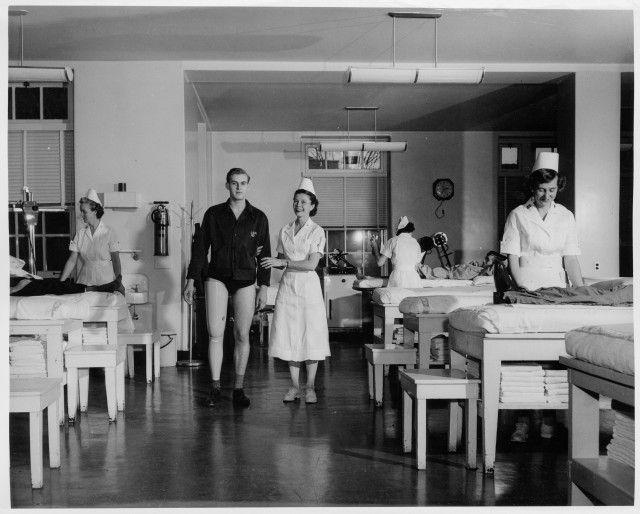WASHINGTON (Army News Service, April 29, 2009) -- Walter Reed Army Medical Center first opened its doors May 1, 1909 as an 80-bed hospital.
Today the 247-bed center is one of the world's premiere medical facilities with 60 outpatient clinics and 16 operating rooms -- combining patient care, teaching and research.
New center for prosthetics training
The Military Advanced Training Center is a recent addition to Walter Reed. The 31,000- square-foot rehabilitation center opened in September 2007. It has cutting-edge technologies like computer- and video-monitoring systems and simulation rooms.
An oval track dominates the second floor of the $8.9-million facility. Here patients learn to walk on their prosthetic limbs.
Servicemembers injured before the days of infra-red camera-assisted motion analysis and treadmills that mimic uneven ground went through different methods of physical therapy.
Before World War II, amputees used an obstacle course, where patients were required to jump from box to box and climb clumsily over obstacles. It was eliminated once therapists found patients achieved better results by receiving instructions and practice on everyday tasks.
"War changes everything in the military," said Sherman Fleek, Walter Reed command historian. "The doctors realized we have to do more than just heal these guys. Let's give them a skill."
Warrior Clinic
The Warrior Clinic, with its Americans with Disabilities Act-compliant restrooms, double- wide doors, lower examining room tables, was specifically designed for wounded warriors and their families. Its comfortable seating, warm amber lighting, and 50-inch flat-screen televisions invite relaxation.
Capt. Ingrid Pacowski is part of the Triad of Care, a concept initiated by the Army Medical Action Plan. It calls for a nurse case manager, who handles the administration of their medical care, and a Warrior Transition Brigade squad leader, who works with the chain-of-command to solve military issues, and a primary care physician.
"It's good for them to have a general doctor who can be like their family doc who then helps all the specialists, bring all their care into one place," Pacowski said. "[They have] some place they can go to sick call; and a doctor they know they can bring their problems to."
Pacowski acts as a medical liaison, delivering medical information to the case manager and chain of command to avoid gaps in treatment.
"The Soldier is getting a comprehensive kind of care in all aspects of their lives," Pacowski said. "Their families are taken care of, their administrative and military stuff is taken care of, their medical side of the house is taken care of, and they've got a nurse case manager who's helping to bring all that stuff together."
WWI begins rehabilitation focus
The teamwork approach used today originated at the outbreak of World War I, when the resources of Walter Reed surgeons, prosthetists, nurses and therapists were consolidated and patients were treated by a team to provide consistent and comprehensive treatment.
Large-scale combat led to a sharp increase in the number of Army nurses, and to a new focus on patient rehabilitation and therapy. The growing need for specialized therapy led to the evolution of the Occupational Therapy and Physical Reconstruction departments at Walter Reed.
"The wounds they came back with, what we saw at Walter Reed was a result of what happened in Europe. They were out to save lives, ensure survivability. The idea of how much of a limb or muscle mass to take wasn't realized," Fleek said. "In World War I we had a lot of amputees. It was like the opening of modern medicine."
Col. Norvel Van Coots, commander of the Walter Reed Health Care System, said many of Walter Reed's recent improvements were brought on by Operations Enduring Freedom and Iraqi Freedom.
"Each of these improvements occurred because we rose to the challenge of sparing no expense, no effort in taking care of these deserving men and women," Coots said. "While each requires constant monitoring and effort to ensure we are meeting the needs of our Warriors in Transition, I believe these developments have made 'the Home of Warrior Care' a reality, and not just a slogan."
"For 100 years, this place has treated hundreds of thousands of people," Fleek added. "Hundreds of thousands of people have passed through those gates and have been healed...and not just the patients, the staff too... these guys are doctors and nurses because it's in their blood."
(For more information on Walter Reed and its history, see the May issue of Soldiers magazine.)


Social Sharing